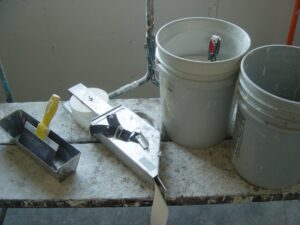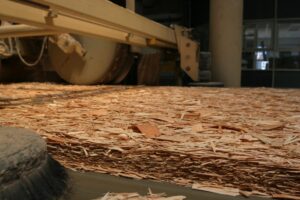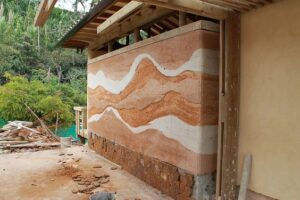 Before I found out I had an allergy to isothiazolinones, I had a strange allergic episode. I was at work, and for multiple weeks straight, my eyes itched to badly that I was pulling out my eyelashes and my nose stuffed up enough to make me feel like I had the flu. The floor below mine was being remodelled, and so I called the building manager to ask if they were doing a lot of drywalling (drywall dust being something I knew I reacted to). To my surprise, he said they were putting up prefabricated wall panels, and the only thing they did to them was to paint them.
Before I found out I had an allergy to isothiazolinones, I had a strange allergic episode. I was at work, and for multiple weeks straight, my eyes itched to badly that I was pulling out my eyelashes and my nose stuffed up enough to make me feel like I had the flu. The floor below mine was being remodelled, and so I called the building manager to ask if they were doing a lot of drywalling (drywall dust being something I knew I reacted to). To my surprise, he said they were putting up prefabricated wall panels, and the only thing they did to them was to paint them.
Since then, I’ve learned a lot more about my allergies, and I’ve learned that isothiazolinones are found as preservatives in water-based paints, including latex house paint. It now makes sense. That doesn’t make it any easier. Paint is everywhere, and you usually can’t predict whether a public building has painted recently before you go. Luckily paint off-gasses and over time becomes more benign. But it’s not just paint I react to; most other wood finishes contain colophony. Even low-VOC paints can contain masking agents, solvents, and other toxic chemicals. I want to build my own house someday. How do I finish my walls and live comfortably in my future new home?
Luckily, there are a number of other options for finishing walls and wood. Most of them are surprisingly stylish if used in the right ways. Some are relatively inexpensive and some more costly, some are easy and some require more work and maintenance. Here are a few that I found:
-

Production of Strawboard
Strawboard – A more environmentally-sustainable alternative to drywall. While not a wall finishing material or method, strawboard may provide an excellent base for some of the finishes below. It is extremely fire resistant (won’t burn because all of the oxygen is squeezed out) and provides sound-dampening properties. It’s made of only compressed straw, unbleached paper, and adhesives, and is extremely strong.
Plaster, brick, and concrete – Keep your walls unfinished with a solid material for a rustic look. - Tile – A single tile wall can be a great accent to a room. Play up the design with small tiles or a mosaic, or use large tiles for a cleaner look.
Glass – Clear glass panels can divide spaces to give your home an open feel, and frosted glass panes can be used to divide more private rooms from other areas. - Metal – Stainless mesh curtains can provide a modern screen between rooms. Perforated or corrugated metal sheets give an industrial look.
- Milk paint – True milk paint comes as a powder that you mix yourself, and should have no odour when dry. It can be burnished to create a semi-gloss surface, but should be sealed if it is on a surface that could get wet, as it is not waterproof. It requires a porous surface for application, but some wall surfaces may be too porous and require some sort of sealing first.
- Wallpaper – Depending on the adhesive and the nature of the paper, wallpaper may be a good option for a wall covering with lower chemical off-gassing.
-

Rammed Earth Wall
Rammed earth – Highly-compacted earth can be strong and hard like concrete, while having a unique, striated, earthy look. At about 12 inches thick, they also act as excellent heat sinks for maintaining a more constant temperature in your home and provide some noise dampening.
- Facades – Stone and brick, whether real stone or man-made, can be applied to the surface of the wall for many different looks.
- Finished wood – Finished with any number of commercial finishes, if you can handle them, and oils if you can’t. Oiled wood can be a bit more high-maintenance. Easy to use as screens between rooms or as entire walls.
- Unfinished, kiln-dried wood – Only for dry, indoor environments. Unfinished wood will change significantly over time, so be sure you know what you’re getting yourself into. I suggest kiln-dried wood because kiln-drying produces more stable wood and helps kill any microorganisms that might have been living in the wood.
- Shou Sugi Ban – This is a Japanese method of finishing wood, involving charring, cooling, sanding, washing, and oiling. Traditionally, Japanese cedar was used, but the process can be done with other woods like Western red cedar, douglas fir, cyprus, pine, and oak. The resulting wood is resilient enough to last for up to 80 years outdoors, and is resistant to insects, fire, and rotting, though it does require annual oiling. Colours range from almost black to relatively close to original colour, but with more pronounced grain lines. It can even be used for flooring.
- Waxed wood – Use beeswax or another similar wax. The French technique of using a “polissoir” creates a beautiful, shiny finish. (http://www.popularwoodworking.com/techniques/finishing/my-introduction-to-the-polissoir-roubos-wax-polisher)
- Fabric – Take a look at pictures of sumptuous rooms of the rich from the 1500s. You will find hanging draperies against the walls or fabric attached to the walls, in beautiful silk brocades and velvets. Nowadays that might be a bit much for most rooms, but many fabrics can work the same way, ranging from a nice linen or hemp weave for an earthy look, to a shimmering silk, to one of the millions of synthetic weaves and patterns, if you can handle synthetics. For the healthiest covering, try organic fabrics and natural pastes or some other method of attachment.

Shou Sugi Ban
What if you don’t have a choice, or your walls were recently painted? The best method is to remove it. Scrape it off or replace wall panels, taking precautions to protect yourself if dealing with lead paints. If you can’t remove it, you can seal it into the wall with a sealing primer, but you’d have to find one that doesn’t contain the chemicals which cause you to react.
If you can’t do that, you can speed up the process. Paint releases VOCs and other chemicals as it dries and cures, and this process can continue indefinitely, though it usually drops off significantly after a few weeks. The chemicals travel through the paint and into your room; they aren’t released solely from the outer surface. To cure paint faster, make the environment warm and dry. Use a dehumidifier, open windows if you can, use fans, and turn up the heat to keep the room warm.
It’s amazing how many alternatives to traditionally-painted wall finishes are out there. I hope this collection of wall finishing options helps you as much as I hope it will help me in my future.
